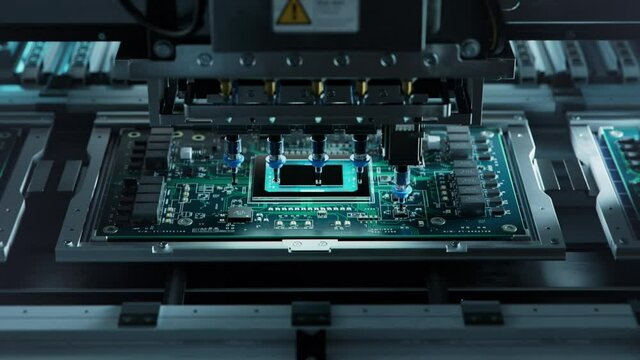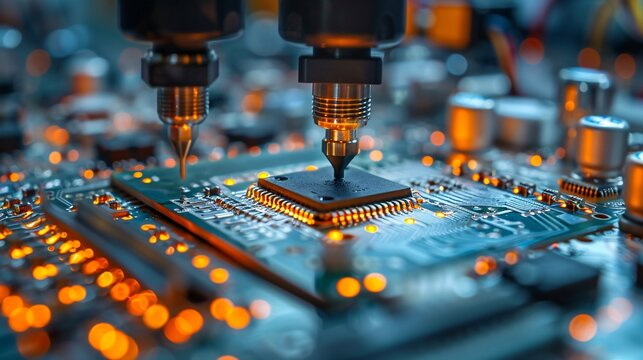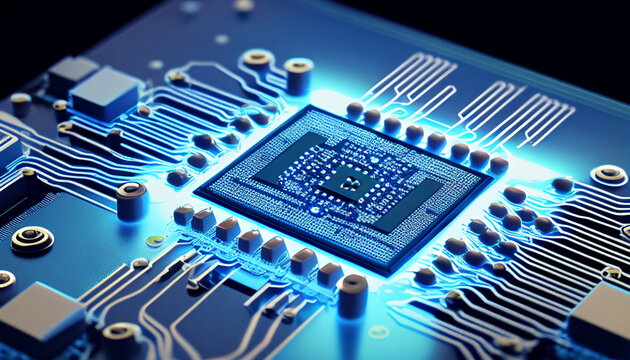Content Menu
● Introduction
● Best Practices for Component Handling
>> 1. Efficient Loading and Unloading
>> 2. Quality Control Measures
>> 3. Inventory and Production Management
>> 4. Error Mitigation
>> 5. Handling Small Components
● Advanced Techniques and Tools
● Optimizing PCB Design for SMT Assembly
● Lean Manufacturing Principles
● Training and Workforce Development
● Conclusion
● FAQ
>> 1. What is the role of automated loaders in SMT lines?
>> 2. How does AOI contribute to quality control?
>> 3. What are common errors in SMT processes?
>> 4. How can MES improve SMT production?
>> 5. What challenges arise when handling small SMT components?
● Citations:
Introduction
Surface Mount Technology (SMT) lines are the backbone of modern electronics manufacturing. Proper handling of components on these lines is crucial to ensure efficiency, quality, and reliability. This article explores the best practices for handling components on SMT lines, offering insights into techniques and tools that enhance productivity and minimize errors.

Best Practices for Component Handling
1. Efficient Loading and Unloading
Automated loaders and unloaders play a vital role in SMT lines. They ensure precise placement of Printed Circuit Boards (PCBs) onto the conveyor belt, reducing the risk of misalignment and damage. Automated unloaders help maintain a steady workflow by carefully removing finished PCBs, preventing contamination and bottlenecks.
- Automated Loading: Automated loaders utilize advanced robotics to position PCBs accurately, ensuring they are ready for the subsequent processing stages without manual intervention.
- Automated Unloading: Similarly, automated unloaders facilitate the efficient transfer of finished products to the next stage of production or inspection, minimizing human error and enhancing throughput.
2. Quality Control Measures
Quality control is paramount in SMT assembly. Inline inspections and Automated Optical Inspection (AOI) systems are essential for maintaining high-quality standards. These systems detect defects such as misaligned components, soldering issues, and insufficient solder paste deposition in real-time, reducing the likelihood of costly rework.
- Inline Inspection: Implementing inline inspection systems allows for immediate feedback during the assembly process, enabling quick corrections before defects propagate through production.
- AOI Systems: AOI systems are crucial for identifying issues that may not be visible to the naked eye. They use high-resolution cameras to capture images of assembled PCBs and analyze them against predefined criteria.
3. Inventory and Production Management
Effective inventory and production management strategies, such as implementing a Manufacturing Execution System (MES), optimize resource utilization and streamline operations. MES systems enhance material flow traceability, production planning, and scheduling, contributing to overall efficiency.
- Real-Time Tracking: MES provides real-time data on inventory levels and production status, allowing manufacturers to make informed decisions quickly.
- Material Flow Optimization: By analyzing material flow patterns, manufacturers can identify bottlenecks and adjust processes accordingly to enhance productivity.
4. Error Mitigation
Common errors in SMT processes can lead to significant quality issues. Techniques like adjusting stencil thickness and maintaining proper component placement pressure are effective solutions to mitigate these errors.
- Solder Beading Prevention: Solder beading can occur due to excessive solder paste deposition or improper reflow techniques. Adjusting stencil thickness or reducing component placement pressure can help prevent this issue.
- Alignment Accuracy: Ensuring high component placement accuracy is essential for avoiding misalignment errors that can compromise solder joint integrity.

5. Handling Small Components
Managing small SMT components requires precision and specialized techniques. For instance, using stencils with appropriate thickness and ensuring proper solder mask design can prevent issues like tilting and solder bridging.
- Stencil Design: The design of stencils used for solder paste application is critical. For small components like 0201s or 01005s, thinner stencils should be employed to control paste volume accurately.
- Solder Mask Considerations: The solder mask design should allow for optimal solder joint formation while preventing excess solder from flowing into unintended areas.
Advanced Techniques and Tools
Technological advancements have introduced tools like X-ray inspection systems and advanced MES software that further enhance the efficiency and reliability of SMT lines. These tools provide deeper insights into soldering quality and production processes, enabling manufacturers to meet high-quality standards.
- X-ray Inspection: This technology is particularly useful for inspecting hidden solder joints in BGAs (Ball Grid Arrays) where visual inspection is not possible.
- Predictive Maintenance: Utilizing machine learning algorithms within MES can predict equipment failures before they occur, allowing for proactive maintenance that minimizes downtime.
Optimizing PCB Design for SMT Assembly
Optimizing PCB design is crucial for efficient assembly on SMT lines. Several best practices can be implemented during the design phase:
- Proper Footprints: Ensure that component footprints are designed according to manufacturer specifications to facilitate accurate placement during assembly.
- Component Orientation: Keeping all surface-mount components oriented in the same direction simplifies assembly processes and reduces errors during component placement.
- Avoiding Overcrowding: Design layouts that avoid overcrowding of components to ensure adequate space for assembly machines to operate efficiently without interference.
Lean Manufacturing Principles
Incorporating lean manufacturing principles into SMT line operations can significantly enhance efficiency by minimizing waste and optimizing workflows:
- Waste Reduction: Identify non-value-added activities in the production process and eliminate them to streamline operations.
- Continuous Improvement: Foster a culture of continuous improvement where employees are encouraged to suggest enhancements based on their experiences on the shop floor.
Training and Workforce Development
A well-trained workforce is essential for maintaining quality standards in SMT production:
- Regular Training Programs: Implement ongoing training programs that keep operators updated on the latest technologies, techniques, and best practices in SMT manufacturing.
- Skill Development: Focus on developing specific skills related to equipment operation, troubleshooting, and quality control among staff members.
Conclusion
Adopting best practices for handling components on SMT lines is essential for achieving high productivity and quality in electronics manufacturing. From efficient loading and unloading to advanced quality control measures, each step contributes to a seamless production process. By leveraging modern tools and techniques while optimizing PCB designs according to industry standards, manufacturers can stay ahead in the competitive electronics industry. Furthermore, integrating lean manufacturing principles alongside continuous workforce training ensures sustained improvements in efficiency and product quality over time.

FAQ
1. What is the role of automated loaders in SMT lines?
Automated loaders ensure precise placement of PCBs onto conveyors, reducing misalignment risks while enhancing workflow efficiency.
2. How does AOI contribute to quality control?
AOI systems identify defects like misaligned components or soldering issues in real-time during assembly processes, ensuring high-quality standards are maintained.
3. What are common errors in SMT processes?
Common errors include solder beading and misalignment; these can be addressed through techniques such as adjusting stencil thickness or ensuring accurate component placement pressure.
4. How can MES improve SMT production?
MES systems optimize inventory management by providing real-time tracking of materials while enhancing production planning capabilities for better workflow management.
5. What challenges arise when handling small SMT components?
Challenges include tilting or solder bridging; these issues can be mitigated through careful stencil design and appropriate solder mask considerations during PCB layout planning.
Citations:
[1] https://www.hayawin.com/news-how-do-you-handle-pcbs-in-smt-production-line.html
[2] https://www.wevolver.com/article/smt-process
[3] https://www.smtfactory.com/Optimizing-Efficiency-Strategies-for-A-Smooth-SMT-Line-Production-Process-id47463586.html
[4] https://www.protoexpress.com/blog/common-errors-surface-mount-technology-smt/
[5] https://en.wikipedia.org/wiki/Surface-mount_technology
[6] https://www.adoptsmt.com/en/efficiency-enhancement-in-smt-manufacturing/
[7] https://blogs.sw.siemens.com/valor-dfm-solutions/how-to-optimize-pcb-design-for-the-smt-assembly-process-flow/
[8] https://www.ioscm.com/blog/industry-insights-pcb-manual-assembly-or-smt-line-assembly/
[9] https://txjpcb.com/the-best-practices-for-smt-line-balancing-and-optimization/
[10] https://www.electronicdesign.com/markets/automation/article/21142075/rush-pcb-how-to-handle-small-components
[11] https://www.electronicspecifier.com/news/surface-mount-technology-best-practice-guide
[12] https://www.pcbcart.com/article/content/smt-process-to-cost-reduction.html
[13] https://quality-line.com/smt-quality/
[14] https://resources.pcb.cadence.com/blog/2020-how-to-optimize-pcb-design-for-smt-assembly-process-flow
[15] https://www.protoexpress.com/kb/smt-assembly/
[16] https://www.linkedin.com/pulse/how-improve-smt-production-efficiency-
[17] https://www.ednasia.com/top-12-incredible-techniques-to-control-the-quality-of-pcb-smt-assembly/
[18] https://www.smthelp.com/methods-and-measures-to-improve-the-production-efficiency-of-smt-production-line
[19] https://kicthermal.com/article-paper/process-guidelines-to-ensure-optimal-smt-electronics-assembly/
[20] https://www.neodensmt.com/news/improve-smt-production-efficiency-48868013.html
[21] https://www.raypcb.com/line-efficiency/




















